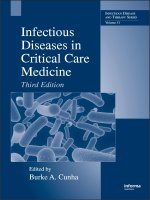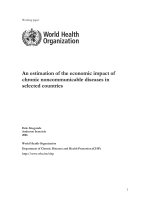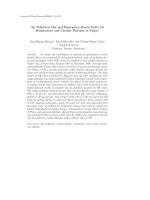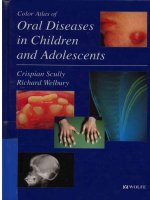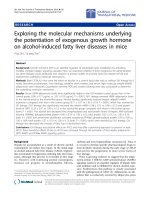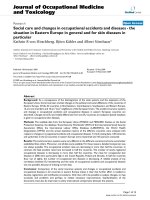2014 uncommon diseases in ICU
Bạn đang xem bản rút gọn của tài liệu. Xem và tải ngay bản đầy đủ của tài liệu tại đây (3.75 MB, 204 trang )
Uncommon
Diseases in the ICU
Marc Leone
Claude Martin
Jean-Louis Vincent
Editors
Uncommon Diseases in the ICU
Marc Leone Claude Martin
Jean-Louis Vincent
•
Editors
Uncommon Diseases
in the ICU
123
Editors
Marc Leone
Claude Martin
Anesthésie et réanimation
CHU Nord
Marseille
France
Jean-Louis Vincent
Department of Intensive Care
Erasme Hospital
Brussels
Belgium
Translation from the French language edition ‘Maladies rares en réanimation’ by Marc
Léone, Ó Springer-Verlag France, Paris, 2010; ISBN 978-2-287-99069-4.
ISBN 978-3-319-04575-7
ISBN 978-3-319-04576-4
DOI 10.1007/978-3-319-04576-4
Springer Cham Heidelberg New York Dordrecht London
(eBook)
Library of Congress Control Number: 2014934138
Ó Springer International Publishing Switzerland 2014
This work is subject to copyright. All rights are reserved by the Publisher, whether the whole or part of
the material is concerned, specifically the rights of translation, reprinting, reuse of illustrations,
recitation, broadcasting, reproduction on microfilms or in any other physical way, and transmission or
information storage and retrieval, electronic adaptation, computer software, or by similar or dissimilar
methodology now known or hereafter developed. Exempted from this legal reservation are brief
excerpts in connection with reviews or scholarly analysis or material supplied specifically for the
purpose of being entered and executed on a computer system, for exclusive use by the purchaser of the
work. Duplication of this publication or parts thereof is permitted only under the provisions of
the Copyright Law of the Publisher’s location, in its current version, and permission for use must
always be obtained from Springer. Permissions for use may be obtained through RightsLink at the
Copyright Clearance Center. Violations are liable to prosecution under the respective Copyright Law.
The use of general descriptive names, registered names, trademarks, service marks, etc. in this
publication does not imply, even in the absence of a specific statement, that such names are exempt
from the relevant protective laws and regulations and therefore free for general use.
While the advice and information in this book are believed to be true and accurate at the date of
publication, neither the authors nor the editors nor the publisher can accept any legal responsibility for
any errors or omissions that may be made. The publisher makes no warranty, express or implied, with
respect to the material contained herein.
Printed on acid-free paper
Springer is part of Springer Science+Business Media (www.springer.com)
Preface
Goals of the Book
This book aims to provide concise and pragmatic guidelines to clinicians managing patients with uncommon diseases at the bedside. After a brief introduction,
the book is divided into nine chapters including several questions. Each chapter is
related to either a specific organ (heart and vessels, lungs, nervous system, skin,
kidneys, liver) or a type of affection (infections, internal medicine diseases). The
authors received specific guidelines: short introduction focusing on epidemiology
and pathophysiology, detailed description of the diagnostic approach, and practical
management recommendations. Illustrations and algorithms are requested in order
to facilitate the understanding of the disease. A minimal number of references are
needed, including an exhaustive review published in a major journal, if available.
In the chapter related to the cardiovascular system, the readers will find articles
related to the Tako-Tsubo cardiomyopathy, Brugada syndrome, calcium channel
disorders, pulmonary hypertension, and pheochromocytoma. The chapter related
to infectious diseases includes descriptions of the Lemierre’s syndrome, rickettsiosis, Strongyloides hyperinfection syndrome, dengue virus infection, and
Chikungunya virus infection. The chapters ‘‘respiratory diseases,’’ ‘‘renal disease,’’ and ‘‘liver system’’ detail the pulmonary fibrosis, Gitelman and Bartter
syndromes, and uncommon liver diseases. In the chapter on the nervous system,
the reader will find responses on myasthenia, amyotrophic lateral sclerosis, and
Parkinson disease. Immunological diseases, metabolic disease, and mitochondrial
affection are presented in a chapter entitled ‘‘internal medicine diseases.’’ In a
chapter related to the hematological system, the reader will find details about the
hemolytic anemia, retinoic acid syndrome, and thrombotic thrombocytopenic
purpura. The ‘‘skin diseases’’ chapter includes descriptions of the hereditary
angioedema and toxic epidermal necrolysis.
v
vi
Preface
Summary for Readers
Although uncommon diseases have a low prevalence in the general population,
they can affect a large number of patients admitted to intensive care units. An
uncommon disease can be diagnosed in the intensive care unit. Often, a complication of the disease by itself leads to the patient’s admission to intensive care unit.
This book does not aim to provide an exhaustive description of those diseases.
The goals were to focus on the major diseases that the intensivists can meet in their
clinical practice. The most relevant features for the management in intensive care
unit are reported.
The authors have promoted the practical characteristics of uncommon disease.
After a brief introduction on the epidemiology and pathophysiology of each disease, the authors emphasize the aspects related to diagnosis and treatment. In this
book, the residents and intensivists facing patients with uncommon diseases would
appreciate to find concise and pragmatic responses.
Contents
Part I
Introduction
Genetic Aspects of Uncommon Diseases . . . . . . . . . . . . . . . . . . . . . . .
Julien Textoris and Marc Leone
Part II
3
Cardiovascular System
Takotsubo Syndrome. . . . . . . . . . . . . . . . . . . . . . . . . . . . . . . . . . . . .
Aude Charvet
15
Brugada Syndrome . . . . . . . . . . . . . . . . . . . . . . . . . . . . . . . . . . . . . .
D. Lena, A. Mihoubi, H. Quintard and C. Ichai
21
Cardiovascular Disease: Calcium Channel Anomalies . . . . . . . . . . . . .
Christopher Hurt, David Montaigne, Pierre-Vladimir Ennezat,
Stéphane Hatem and Benoît Vallet
29
Pulmonary Arterial Hypertension in Intensive Care Unit . . . . . . . . . .
Laurent Muller, Christian Bengler, Claire Roger,
Robert Cohendy and Jean Yves Lefrant
37
Part III
Infectious Diseases
Strongyloidiasis in Intensive Care . . . . . . . . . . . . . . . . . . . . . . . . . . .
Laurent Zieleskiewicz, Laurent Chiche, Stéphane Donati
and Renaud Piarroux
61
Dengue in the Intensive Care Unit . . . . . . . . . . . . . . . . . . . . . . . . . . .
Frédéric Potié, Olivier Riou and Marlène Knezynski
69
vii
viii
Contents
Chikungunya in the Intensive Care Unit . . . . . . . . . . . . . . . . . . . . . .
Olivier Riou, Marlène Knezynski and Frédéric Potie
79
Snakebite Envenoming . . . . . . . . . . . . . . . . . . . . . . . . . . . . . . . . . . .
Jean-Pierre Bellefleur and Jean-Philippe Chippaux
85
Part IV
Respiratory System
Diffuse Interstitial Lung Disease and Pulmonary Fibrosis . . . . . . . . . .
Jean-Marie Forel, Carine Gomez, Sami Hraiech and Laurent Chiche
Part V
99
Nervous System
Amyotrophic Lateral Sclerosis . . . . . . . . . . . . . . . . . . . . . . . . . . . . . .
Stéphane Yannis Donati, Didier Demory and Jean-Michel Arnal
115
Parkinson’s Disease in Intensive Care Unit . . . . . . . . . . . . . . . . . . . .
Lionel Velly, Delphine Boumaza and Nicolas Bruder
125
Part VI
Internal Medicine Diseases
Management of Autoimmune Systemic Diseases
in the Intensive Care Unit . . . . . . . . . . . . . . . . . . . . . . . . . . . . . . . . .
L. Chiche, G. Thomas, C. Guervilly, F. Bernard,
J. Allardet-Servent and Jean-Robert Harlé
Mitochondrial Diseases . . . . . . . . . . . . . . . . . . . . . . . . . . . . . . . . . . .
Djillali Annane and Diane Friedman
Part VII
153
Hematological Diseases
Hemolytic Anemias Resuscitation in Adults . . . . . . . . . . . . . . . . . . . .
Régis Costello and Violaine Bergoin-Costello
Part VIII
141
165
Skin System
Bradykinin-Mediated Angioedema . . . . . . . . . . . . . . . . . . . . . . . . . . .
Bernard Floccard, Jullien Crozon, Brigitte Coppere,
Laurence Bouillet and Bernard Allaouchiche
175
Contents
ix
Toxic Epidermal Necrolysis in Children . . . . . . . . . . . . . . . . . . . . . . .
Fabrice Michel
Part IX
Renal System
The Gitelman and Classical Bartter Syndromes . . . . . . . . . . . . . . . . .
Guillaume Favre, Jean-Christophe Orban and Carole Ichai
Part X
191
199
Liver System
Uncommon Liver Diseases in ICU . . . . . . . . . . . . . . . . . . . . . . . . . . .
Catherine Paugam-Burtz and Emmanuel Weiss
207
Part I
Introduction
Genetic Aspects of Uncommon Diseases
Julien Textoris and Marc Leone
Key Points
• Hereditary diseases represent 80 % of the rare diseases
• Hereditary diseases are the consequence of the pathological modification
of one or a few genes
• The diagnosis, which may be done before birth, is confirmed by the
identification of one or more mutations
• The knowledgebase ‘‘Orphanet’’ ( is the reference
website for updated informations on genetic and rare diseases.
Genetic diseases are those that are caused by the alteration of a gene. They
represent 80 % of so-called ‘‘rare diseases’’ (whose prevalence is less than one
case for 2,000 persons), or approximately 6,000 pathologies. Interestingly, the
prevalence of adult respiratory distress syndrome is estimated at 30/100,000. It
shows that the notion of disease rarity is relative when it comes to intensive care
medicine! Genetic diseases affect 1–2 % of births in the world, or approximately
10 million people in Europe. People suffering from genetic diseases are therefore
alone and isolated but, at the same time, they represent a large population. That
explains why these diseases are a real public health priority. Fortunately, not all
genetic diseases lead to intensive care unit. Aggressive medical management in the
intensive care unit is not always the only available solution and should in most
cases be considered in light of a multidisciplinary team and ethical approach.
Rare or orphan diseases have been acknowledged since the beginning of the
1980s. The United States provided a first definition in the Orphan Drug Act that
J. Textoris (&) Á M. Leone
Service d’anesthésie et de réanimation, Hôpital Nord, Assistance Publique-Hôpitaux
de Marseille, Université de la Méditerranée, Chemin des Bourrely 13915,
Marseille Cedex 20, France
e-mail:
M. Leone et al. (eds.), Uncommon Diseases in the ICU,
DOI: 10.1007/978-3-319-04576-4_1, Ó Springer International Publishing Switzerland 2014
3
4
J. Textoris and M. Leone
passed in 1983: ‘‘Any disease affecting less than 200,000 people’’, which at the
time was equivalent to a prevalence of 7.5/10,000 in the United States. The
prevalence threshold is 4/10,000 in Japan. In France, it is 5/10,000. Various plans
to provide medical care for rare diseases have emerged in France. In 1992, a fasttracked procedure was implemented to allow orphan diseases drugs to be granted
marketing authorisation. In 1995, a commission for orphan drugs was established
and in 1997, Orphanet, a portal on rare diseases and orphan drugs, was set-up.
More recently, the National Plan on Rare Diseases (2005–2008) was launched to
‘‘ensure equity in the access to diagnosis, treatment and provision of care’’. The
plan led to the creation of centres of reference on rare diseases. To give a few
examples, in France, about 15,000 people suffer from sickle cell disease, 8,000
from amyotrophic lateral sclerosis, 6,000 from cystic fibrosis, 5,000 from Duchenne muscular dystrophy, 500 from leukodystrophy, while only a few cases of
progeria are reported. 65 % of rare diseases in France are serious and debilitating;
they have an early onset (appearing before the age of 2 in two cases out of five);
they cause chronic pain in one patient out of five; they lead to the occurrence of a
motor, sensory or intellectual deficit in half of the cases, and to a disability or loss
of autonomy in one case out of three. Overall, rare diseases are life-threatening in
half of the cases.
Physiopathology of Genetic Diseases
Genetic diseases result from a pathological change in one or several gene(s).
Among these are distinguished:
• Hereditary genetic diseases, transmitted to the offspring via the reproductive
cells, namely gametes.
• Multifactorial diseases, the majority of which are caused by multiple factors:
environment, lifestyle and type of food consumption, biological and genetic
factors. This is the case for cancers, for some types of cardiovascular diseases,
for neurodegenerative diseases, and for infectious diseases. The respective roles
played by the various factors in these diseases is highly variable. And so is the
degree of incidence of the mutated genes.
Among genetic diseases, a distinction can be made between those caused by the
mutation of a single gene and those resulting from the ‘‘accumulation’’ of multiple
genetic abnormalities. The first ones are called ‘‘monogenic’’ or ‘‘Mendelian’’
since their transmission pattern follows the laws discovered by Mendel. The
genetic diseases whose transmission is not Mendelian involve several genes, as
well as non-genetic factors. This is the case of mitochondrial diseases (mitochondria are elements present in the cells, intended to generate the necessary
energy for the cells), where the mutation affects the mitochondrial genome. Their
transmission is particular as only women can pass them on and because the
Genetic Aspects of Uncommon Diseases
5
mutated-gene expression is often mosaic. It is also the case of chromosomal
diseases linked to the absence of a chromosome or to its presence in excess (such
as Trisomy 21), or to abnormalities of the chromosome structure itself. Genetic
diseases are also classified according to the organs and physiological functions
they affect.
Finally, the penetrance of the disease is extremely variable, even within a
family, which often complicates diagnosis and prenatal counselling.
Diagnosis and Treatments
Today, a gene mutation associated with a multifactorial disease can be identified
through genetic testing.
However, given the many genes involved in these diseases, these tests do not so
much provide information to foresee the evolution of these pathologies, as they
provide information on the existence of a risk factor in a family’s genetic makeup.
However, the main benefit of genetic testing is to help formulate a diagnosis for
patients showing clinical signs. Erroneous clinical diagnoses can therefore be
definitely ruled out and those at risk can be screened.
Prenatal diagnosis is a genetic test performed on a fetus. It is a rare procedure,
only intended for parents who may transmit a severe, incurable hereditary disease
to their child. A prenatal diagnosis is proposed to families at risk following a
specialized consultation. In addition to providing information and assessing the
risk of a genetic disease, this consultation also allows the parents to benefit from a
suitable psychological support.
The acknowledgement of rare diseases being recent, the development of specific treatments has only been prioritised by public authorities in the last 20 years.
For the majority of the diseases, there is still no hope for a cure. Gene therapy is a
very promising perspective.
The principle of gene therapy is simple: the genome of a cell is corrected by
replacing a defaulting gene with its functional copy into the cell. Through this
technique, it is therefore possible to correct a defective function or to compensate
for a missing function in the target cell. The first significant success of this method
was obtained in 2000 by the team of Dr. Marina Cavazzana-Calvo and Pr Alain
Fischer, who succeeded in curing young children suffering from rare severe
combined immunodeficiency (SCID), through the introduction of a gene-drug in
their bone marrow cells.
Cell therapies use specific cells, administered to prevent, cure or mitigate a
disease. Some of them have already proven their worth: transfusion of red blood
cells and platelets to treat some types of blood diseases; skin graft for victims of
severe burns; transplantation of stem cells that can produce massive populations
of different cells and regenerate a damaged tissue; transplantation of insulinproducing cells (the islets of Langherans) to treat insulin-dependent diabetes;
transfer of dendritic cells which induce and regulate an immune response when the
25
Hereditary spherocytosis 20
20
20
AR
29
Congenital
hypothyroidism
Alpha-1-antitrypsin
deficiency
Atresia of the small
intestine
Isolated scaphocephaly
AR
Osteochondritis dissecans 35
Malignant hyperthermia 33
Marfan syndrome
30
25
AD
AD
AD
35
Elliptocytosis
Long QT syndrome
AD
44
Arrhythmogenic right
ventricular dysplasia
Spo./
Neo./Inf.
AR
Spo./
Neo./Inf.
AD
AD/AR Variable
Normal if newborn
bilirubinencephalopathy is
avoided
Depends on the length of
the small intestine
Normal
Severe anemia in neonates
POC
POC
Heart (sudden death)
Linked to the pulmonary
Liver (cirrhosis) lung
and hepatic dysfunction
(emphysema)
AD/AR Childhood Normal risk = sudden
death
Variable
Coma, …
POC
Rhabdomyolysis
Cardio-vascular
Severe anemia, POC
Heart (peri-operative, or initial
heart failure)
Heart (sudden death, or heart
failure at advanced stages)
Survival [85 % after ttt
Normal risk = sudden
death
Reason for ICU admission
Lifespan
Normal (only 5–20 % have
a severe disease)
Ado./Ad. Normal
Variable Mortality \5 %
Childhood Depends on cardiovascular
complications
Neo./Inf. Normal if early detection
Variable
Spo./
Neo./Inf.
AD
AD/AR Ad.
45
Tetralogy of fallot
Type of Onset
heredity (year)
Estimated
prevalence
(/100,000)
Disease’s name
Table 1 Genetic diseases that may be seen in ICU and whose prevalence is estimated between 5 and 50/100,000
(continued)
Transfusion ± EPO
Splénectomie
Surgery
Alpha-1 antitrypsin (IV)
ongoing clinical trials,
lung/liver transplant
Beta-blockers, cardiac
sympathic neurolysis
Implantable cardioverterdefibrillator
Surgery
Substitutive opotherapy
Drugs, implantable
cardioverterdefibrillator++
Folic acid, transfusion,
splenectomy
Physiotherapy, Surgery
Dantrolene
Multidisciplinary
Surgery
Treatment
6
J. Textoris and M. Leone
Estimated
prevalence
(/100,000)
Neo./Inf.
12.5
12
Cystic fibrosis
AD/AR Variable
12.5
Supravalvular aortic
stenosis
AR
15
Deficiency of acyl-CoA
dehydrogenase
medium chain fatty
acids
Von Willebrand disease
AR
AD
AR
Neo./Inf.
Variable
Neo./Inf.
Neo./Inf.
15.6
Disease of the maple
syrup
MH
16
MELAS syndrome
Slightly reduced (risk of
sudden death)
Depends on mental status
Lifespan
Severe hypoglycemia
Cerebral (seizures), Lung
(myopathy), heart (heart
failure)
Cerebral (coma,
encephalopathy)
–
Heart (sudden death, or heart
failure at advanced stages)
Epilepsy
Reason for ICU admission
Hemodiafiltration, some rare
forms are cured by
thiamine administration
Glucose (massive amounts)
Ongoing clinical trials
Symptomatic/palliative
Drugs, implantable
cardioverterdefibrillator ++
Symptomatic/palliative
Treatment
(continued)
Cerebral (hemorragic stroke),
Depends on subtypes, von
hemorragic shock
Willebrand factor,
(perioperative, delivery, …)
desmopressine
Variable but almost normal Heart (Infarction, heart failure, Surgery
sudden death),
hypercalcemia, POC
*35–40 years
Lung (failure), liver (cirrhosis) Symptomatic/palliative
Normal
Acute form: death in the
first weeks of life if
undiagnosed
Normal if diagnosed
Death in utero, or near
birth
Childhood Variable but prognosis is
severe
17
RX/
Variable
AD/
AR/
MH
AD
Neo./Inf.
AR
Type of Onset
heredity (year)
Bilateral renal agenesis
Agenesis of the corpus
19
callosum—
neuropathy
Dilated cardiomyopathy, 17.5
familial
Table 1 (continued)
Disease’s name
Genetic Aspects of Uncommon Diseases
7
10
Catecholaminergic
polymorphic
ventricular
tachycardia
Abnormal mitochondrial
oxidative
phosphorylation
(nuclear DNA)
Tuberous sclerosis
Pierre Robin syndrome
isolated (isolated
Pierre Robin
sequence)
Duodenal atresia
10
Isolated plagiocephaly
Spo./
AR
Spo./
AD
8.8
8.6
Lung (chronic failure), heart
(heart failure)
Neo./Inf.
Normal
Neonatal ICU and POC
Childhood Normal with the exception Cerebral (seizures), lung
of uncontrolled seizures
(failure)
Neo./Inf. Normal if diagnosed early Lung (obstructive disease)
Reduced, but depends on
the age of onset
Transfusion, hydroxyurea in
severe forms
Substitutive opotherapy GH),
special diet
Chemotherapy ? surgery
Treatment
Surgery
(continued)
Depends on localisation of
tumors
Surgery
Symptomatic/palliative
Beta-blockers
Acute metabolic events
Substitutive opotherapy
(hyopnatremia,
hyperkaliemia, acidosis;
severe hypoglycemia)
Intra cranial hypertension, POC Surgery
Lung (thoracic syndrome),
cerebral (Stroke)
Lung (chronic failure), heart
(heart failure)
POC
Reason for ICU admission
Spo./
Neo./Inf. Normal
AD
AD/AR Childhood Without treatment, sudden Heart (sudden death)
death before 20. Risk is
reduced by treatment
AR
Reduced (30–40 years)
Unpredictable
Lifespan
Childhood Survival [90 % with
treatment
Neo./Inf. Good
AD
10
Congenital adrenal
hyperplasia
AD
Neo./Inf.
8.8
10.1
Nephroblastoma
Chr 15
Variable
AR/MH Variable
10.7
Prader-Willi syndrome
AR
Type of Onset
heredity (year)
9
11
Estimated
prevalence
(/100,000)
Sickle cell disease
Table 1 (continued)
Disease’s name
8
J. Textoris and M. Leone
AD/MF Neo./Inf.
AD
AR
AR
AR
Spo./
Adult
AD/
AR
7.3
7
7
7
7
6.6
6.5
6
Holoprosencephaly
Sotos
Galactosemia
Autosomal recessive
polycystic kidney
disease
Amyotrophic lateral
sclerosis
AD
AD
–
May be normal. Depends
on the frequency and
severity of seizures
Normal
Lifespan
POC (omphalitis), Severe
hypoglycemia
Lung failure
Hemorragic shock, POC
Neurological (Guillain-Barré),
liver
Reason for ICU admission
60–65 years
Lung (failure)
About 10–20 % in neonatal Lung (hypoplasia
period
(diaphragmatic hernia),
heart (malformations),
Neuro
Neo./Inf. High heterogeneity, so
Lung (apnea), heart (rythmic
variable. Severe forms
disease), cerebral (seizures),
die in neonatal period
metabolic (diabetes
insipidus)
Neo./Inf. Normal
Heart (malformations), cerebral
(seizures), hypoglycemia
Neo./Inf. Normal if diagnosed early Liver failure, septic shock
Childhood Normal
Kidney (chronic failure)
Neo./Inf.
Childhood Normal
Neo./Inf.
Beckwith-Wiedemann
syndrome
Dystrophy
Facioscapulohumeral
Fryns syndrome
RX
7.7
Hemophilia
AD/AR Variable
Type of Onset
heredity (year)
8
Estimated
prevalence
(/100,000)
Acute hepatic porphyria
Table 1 (continued)
Disease’s name
(continued)
Symptomatic/palliative
Galactose-free diet
Dialysis, transplantation
Symptomatic/palliative
Symptomatic/palliative
Physiotherapy, mechanical
ventilation
Surgery, but mainly palliative
Transfusion of the missing
factor
Surgery, glucose
Hemine (IV) carbone
hydrates, liver transplant
Treatment
Genetic Aspects of Uncommon Diseases
9
RX
AR
5
5
5
5
X-linked
adrenoleukodystrophy
Ciliary dyskinesia
Duchenne muscular
dystrophy and Becker
Hereditary fructose
intolerance
Lifespan
Variable
Surgery, symptomatique
Treatment
Liver (acute hepatitis, cirrhosis) D-penicillamine,
Triethylenetetramine
Adrenal deficiency
Substitutive opotherapy,
genetic therapy currently
evaluated
Lung (obstructive disease),
Symptomatique, Kine
heart (malformations)
respiratoire,
transplantation
pulmonaire dans de rares
cas
Lung (restrictive disease), heart Symptomatic/palliative
(chronic heart failure)
Acute liver failure and
Fructose, sorbitol and
hemorragic shock if masive
saccharose free diet
amounts of fructose are
ingested
Lung failure
Reason for ICU admission
Heredity: Spo. sporadic, AD autosomic dominant, AR autosomic recessive, X recessive linked to X, MH mitochondrial heredity, MF multifactorial. Onset
age: Neo. neonatal, Inf. infancy, Ado. adolescence, Ad. adult, POC post operative care
Childhood Duchenne : 30–40 years
Beckert: sub-normal
Neo./Inf. Normal if diagnosed early
Slightly reduced is lung
disease is well treated
Variable
Variable: adults with few
symptoms and severe
forms with neonatal
death
Childhood Normal
Neo./Inf.
AD/AR Neo./Inf.
RX
AR
5.8
Wilson disease
AD
Type of Onset
heredity (year)
6
Estimated
prevalence
(/100,000)
Treacher-Collins
syndrome
Table 1 (continued)
Disease’s name
10
J. Textoris and M. Leone
Genetic Aspects of Uncommon Diseases
11
immune system no longer recognizes, and therefore no longer rejects, foreign
tumor cells; transfer of a certain type of liver cells, hepatocytes, which present a
selective advantage to repopulate and rebuild a damaged liver.
Protein replacement therapy consists in replacing a defective protein by a
recombinant protein. For example, in the case of Gaucher’s disease, characterized
by a deficiency in glucocerebrosidase, an enzyme whose recombinant form has
been developed and used to replace the missing enzyme.
Finally, one should also mention the classic approach based on drug administration, which for example has been explored in the treatment of hereditary
tyrosinemia, a liver disease occurring in children under the age of one, which
results from the accumulation of metabolites causing oxidative damages to the
cell. The treatment of this disease is nowadays improved by the administration of
an inhibitor of the tyrosine metabolism.
Genetic Disease and Intensive Care
Given the large number of genetic disorders which can lead to intensive care
admission, we have opted to present in a table the Mendelian genetic diseases
whose prevalence range from 5 to 50/100,000 (in comparison, the prevalence of
pulmonary fibrosis is 7/100,000, that of familial forms of Parkinson’s disease is
15/100,000 and that of lupus is 50/100,000). All the information presented in the
table is drawn from the Orphanet website ( a world reference in the field of rare diseases. It has a good search engine, and for each
pathology it provides links to additional articles in French or English. Because the
diseases mentioned in this work are very rare, the information presented here is
likely to be obsolete by the time you read it. Therefore, it is advised to check the
Orphanet website, which is regularly updated. One can also find on that website a
document listing the centres of reference that are approved to provide medical care
for a specific rare disease or a group of rare diseases. ( />orphacom/cahiers/docs/FR/Liste_des_centres_de_reference_labellises.pdf) This
information is essential in order to obtain expert advice and whenever possible, to
transfer the patients to these centres of reference (Table 1).
Part II
Cardiovascular System
Takotsubo Syndrome
Aude Charvet
Key Points
Acute stress cardiomyopathy and differential diagnosis of acute coronary
syndrome, Takotsubo syndrome is rare.
Nevertheless, this pathology may necessitate cardiovascular resuscitation.
Introduction
Takotsubo syndrome, also known as transient apical ballooning syndrome of the
left ventricle, is a stress cardiomyopathy initially witnessed in Japan and increasingly frequent amongst the Caucasian population [1]. It affects predominantly
female elderly patients and mirrors an acute coronary syndrome, most often stress
induced. Clinically, it presents itself as an acute haemodynamic failure associated
to thoracic pain, electrocardiogram anomalies, and a moderate increase of cardiac
enzymes, without significant lesions of coronary arteries. Diagnosis is supported by
the echocardiogram showing an apical systolic dilation of the left ventricle. The
development of this pathology has spontaneously favourable outcomes, although
resuscitation can be necessary. The pathophysiology of Takotsubo syndrome is still
open for debate.
A. Charvet (&)
Service d’anesthésie et de réanimation, Hôpital Nord Assistance
Publique-Hôpitaux de Marseille, Université de la Méditerranée,
Chemin des Bourrely 13915 Marseille Cedex 20, France
e-mail:
M. Leone et al. (eds.), Uncommon Diseases in the ICU,
DOI: 10.1007/978-3-319-04576-4_2, Ó Springer International Publishing Switzerland 2014
15
16
A. Charvet
History
This pathology was first observed in Japan in 1990 by Sato et al. The name
‘‘Takotsubo cardiomyopathy’’ was given to this syndrome due to the ultrasound
appearance of the left ventricle during the systolic phase: with a dilated background and a narrow neck, it resembles a ceramic amphora-shaped pot called a
Takotsubo, used for octopus fishing in Japan. The majority of publications that
followed were principally Japanese, so that it was initially thought of as a phenomenon limited to Asia up to the years 2000. Then, numerous incidences were
reported throughout the world, especially in Europe, the United States and Australia. In 2006, Takotsubo syndrome is included within the acquired cardiomyopathies classification by the American Heart Foundation [2].
Epidemiology
The exact occurrence of Takotsubo syndrome is unknown, due to the novelty of this
pathology, the varying of its symptomatology and its changing diagnostical criteria.
Nonetheless, most studies find a similar incidence, around one to two percent of
patients admitted for acute coronary syndrome [1]. Contributing factors are equally
found in a unanimous fashion: this syndrome usually affects post-menopausal
women and is the result of a stressor. Indeed, about 90 % of all reported cases are
linked to the female gender, within an age range from 58 to 75 years [3]. It is
unknown as to why there exists a strong predominance of female cases. Several
hypotheses have been put forward, such as the pathophysiological role of estrogens,
or the fact that the atheromatous illness being frequent among males could conceal
this syndrome amongst them. Those female patients do not usually have any
noteworthy antecedent or any coronary disease risk factor, except for an ongoing
smoking habit found in around 50 % of them. At last, approximately two-thirds of
female patients have previously suffered a significant stressor, whether it be
physical (surgery, trauma, meningeal hemorrhage, sepsis, severe pain, local or
general anesthesia, weaning from opiates, cocaine poisoning, endocrinopathies,
electro convulsive treatment, chemotherapy, etc.…) and/or psychological (death or
severe illness of a loved one, divorce, road traffic accident, etc.…) [3].
Clinical
The clinical presentation of Takotsubo syndrome is usually close to acute coronary
syndrome, of which it constitutes the main differential diagnosis. Over half of
female patients describe a brutal and sudden onset of an angina type chest pain.
Takotsubo Syndrome
17
Other possible manifestations can be dyspnea and much more rarely fainting,
pulmonary œdema or cardiac arrest [3]. A haemodynamic failure is frequent,
although cardiogenic shock has only been reported as a rare complication.
Paraclinical
The E.C.G. also suggests acute coronary syndrome, frequently accompanied by a
convex elevation of the ST segment (from 34 to 100 % depending on studies),
most of the time in the antero-septo-apical area (V1–V4), sometimes in the inferior
or lateral areas. Other anomalies indicating myocardial ischemia, such as T-wave
negativity in precordials, dielectric constant and AVL, along with occurrence of Qwave in V3 and V4, are all frequent. Widespread micro-voltage, left branch
blocking or QT-interval prolongation have been observed less frequently [4, 5].
The E.C.G can be normal. In each case, analyzing E.C.G. anomalies does not
allow to differentiate Takotsubo syndrome from acute coronary syndrome [4], and
does imply a link to the seriousness of ventricular dysfunction, or to its development [5].
Cardiac enzymes levels most of the time show a moderate increase, particularly
troponin T peaking within 24 h. However, the increase in these markers is lower
than during a genuine acute myocardial infarct, and especially disproportionate to
the widespread reach as observed in imaging.
The coronarography is normal amongst most patients [3, 4], but assumes the
appearance proper to the ventriculography in late systole: hypokinesia or anteroapical akinesia of the left ventricle, responsible for a ballooning, associated to a
reverse basal hypercontractility. The coronarography can sometimes show nonsignificant coronary lesions, as well as vasospasms, which will fade following
local administering of nitrated derivatives. In fact, diagnosing Takotsubo syndrome is most of the time possible during a left ventriculography done on female
patients with suspected acute coronary syndrome.
Transthoracic echocardiography is a key examination enabling the diagnosis of
Takotsubo syndrome. It mimics anomalies specific to apical or septal segmental
kinetics, responsible for a distortion of the left ventricular functioning (left ventricular function of emission of 15–40 % in the acute phase) [6] and for a distal
ballooning. Usually there are no right-hearted anomalies, nor a pericardial outpouring. However, an associated right ventricular dysfunction is possible (Fig. 1).
A cardiac M.R.I. can also confirm left ventricular kinetics anomalies, without
ischemic attack or necrosis, shown by an absence of contrast after a gadolinium
injection. Equally, it allows forecasting the reversibility of noted disorders [6].
When undertaken early, kine-M.R.I. recognizes kinetics-associated disorders,
characteristic to this pathology (Fig. 2).
18
A. Charvet
Fig. 1 Left ventriculogram during Takotsubo syndrome, a diastole; b systole; apical dyskinesia
(ballooning) and basal hyperkinesia
Fig. 2 Echographic image of Takotsubo syndrome, a dilation of the left ventricle in acute phase;
b spontaneous recovery at day 6
Treatment
The optimal treatment for Takotsubo syndrome has not been defined. Most of the
time, patients are already being treated for acute coronary syndrome at the time of
diagnosis by the use of antiplatelets, nitrated derivatives, heparin and betablockers. Once the illness has been diagnosed and in the absence of ventricular
dysfunction, the initial medical treatment may consist of administering reninangiotensin system inhibitors, beta-blockers and antiplatelets. In the event of
coronary spasms observed during the coronarography, calcic inhibitors may be
considered. Given the main pathophysiological hypothesis considered in this
pathology (an excess of catecholamines), it seems preferable to avoid using amines
and beta-agonists. In the event of hemodynamic failure or cardiogenic shock,
dobutamine must be used cautiously, and a hemodynamic mechanical support
Takotsubo Syndrome
19
(extra corporal membranous oxygenation) must be considered rapidly in case of
serious dysfunction. The treatment of Takotsubo syndrome complications is
symptomatic: diuretics, heparin, anti-arrhythmics, etc.… In the acute phase,
patients must benefit from a continuous monitoring in intensive care unit or in
resuscitation, along with the help of echocardiographic supervision.
Evolution
Takotsubo syndrome myocardial kinetics anomalies are transient, with a return to
a normal primary state within a few days or weeks (3–6). Only the E.C.G. can
retain a trace of this event through non-specific signs (repolarization or conduction
troubles, lengthening of QT interval). However, short-term prognosis can be
clouded by serious, indeed fatal, complications, such as a cardiogenic shock, a left
ventricle thrombus, a trouble of ventricular rhythm or of conduction, a mechanical
complication.
The death rate is very low (around 1–2 %), even if the clinical picture is worrying by requiring heavy duty resuscitation [4]. The risk of relapse is equally low.
Pathophysiology
Takotsubo syndrome pathophysiology remains little known. A recent stressful event
or an important emotional burden appear to be trigger factors for this pathology. The
presence of catecholamines at peak level following that stress could well be
responsible for a systemic inflammatory reaction and left ventricle fraction [7]. The
link between the discharge of catecholamines and ventricular dysfunction is already
observed in the meningeal hemorrhage and in pheochromocytoma. The hypothesis
of catecholamines released during stress having a toxic and direct influence onto
cardiomyocytes is thus plausible [7]. Models based on the use of animals have
permitted to copy electrocardiographic modifications and left ventricle kinetics
troubles in a rat subjected to a physical stress (forced immobilization). Nevertheless,
the concentration of catecholamines released in patients with Takotsubo syndrome
is not always high. A microvascular spasm or an intraventricular blocking are other
hypotheses put forward, and a multi-factor origin cannot be excluded.
Conclusion
Takotsubo syndrome is a rare and recent concept, most often affecting elderly
female patients who have suffered an intense stress. In its acute form, it presents as
a particular cardiogenic failure, mimicking a preliminary myocardial infarctus.



